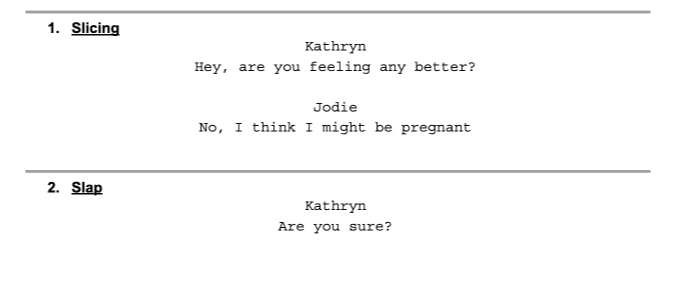Auditions for television and film can seem simple enough for an actor. The sides are a few pages from the full script, used to audition for the role. Reading for a part and making it your own is the key to ensuring a successful audition.
The difficulty lies in elevating the scene by preparing your audition in an effective way, whether your character has one line or 20. How you dissect the script and deliver your audition can make all the difference in bringing you closer to booking the role.
The work is about combining preparation and play. There’s no right or wrong here, just doing your best and enjoying the audition process.
Let’s take a look at how to dissect sides for television and film.
Insights: Quick Tips for Analyzing Sides
- Use a pencil to write notes, a highlighter for your lines and a journal for your character prep.
- Try to memorize your lines as best you can, but always keep the sides close by.
- Read the full script and/or the whole book or play that the project is based on to get a sense of context for your audition.
Read the Sides
Reading the sides might seem like a basic first step, but it’s an important one! As an actor, you’ll be tempted to quickly carve out an emotional journey to show off your skills. However, it’s helpful to understand the script as a whole, and not just what’s happening to your character.
Identify as much information as you can, and don’t just read your own lines. Look at where your character is, what’s happening and who they are talking to. Look at the tone of the scenes — is it a period piece? Are there any important factors to consider, such as is the scene taking place outside, during extreme weather?
Before you think about how you would play the role, look at the sides objectively. Do your homework, too. If you’re auditioning for a well-known television series, watch a few episodes. If the project is based on a book, read it before your self tape or audition.
Doing the work shows commitment and can help determine whether or not you book the role, and the casting director will remember you as the actor who came in with a clear understanding of the material.
Prepare the Character
Once you have read the sides, start looking at the personality traits of the character you are auditioning for. Is there anything in the sides that tell you in factual terms who they are or how you should approach your audition? Look for adjectives that describe your character, or anything other characters might say about them.
You can start to build an internal life for your character by taking the information you have from the sides and any research you have done. It’s also important to make choices about who you think they are and how to approach your audition. Be as authentic and committed as you can, and try not to worry about what you think the casting director wants.
This is your take on the role. You have choices and time to work through them. Trust your intuition when it comes to character work — it’s not about showcasing extreme personality traits or making bold choices to stand out. Do the character work to create the depth needed to bring them to life.
The character work is about showing you can interpret a role effectively, and what makes you an interesting actor is your unique ability to do so.
Thinking about joining Casting Networks? Sign up for a free trial today!
Put the Sides into Context
Once you’ve read through the sides and done the character preparation, it’s time to look at lifting the scene off the page for your audition. This part is about showing your acting skills, by combining the reading and your interpretation of the scene into an actionable performance for your audition.
Go through the sides line by line, and whenever a new piece of information is revealed, draw a line across the page. You should have created sections, labelling each section with a number. Go through the sides again, this time labelling each section with a word.
Choose words that resonate with you, and that evoke the emotion in the scene. The words can be verbs to help give the scene action, or they can be words that work as triggers for you to elevate certain emotions in the scene.
The purpose of this exercise is to help land the beats of the scene. You have to create momentum and give the scene somewhere to go.
The new information is important as it moves the scene along, but in actioning the feeling of each line. You can create an undertone, to show that you have a deeper, emotional understanding of the scene.
For example:

You want to do a good job and show your skills as an actor, however, it’s impossible to show your character’s whole internal life and all the talent you have in one small scene. Remember, the sides aren’t a test. It’s not about being big and bold, or taking the scene to a place where it doesn’t make sense.
Sides are a small excerpt of a larger script, and they are designed for actors to show the casting director that they know how to read, interpret and act within a specific context. Using these tools, you can break down the sides in an easy, but effective way to have a successful audition.
You may also like:













